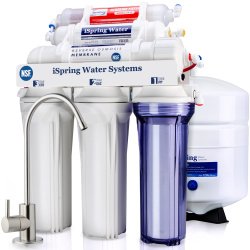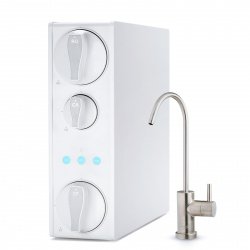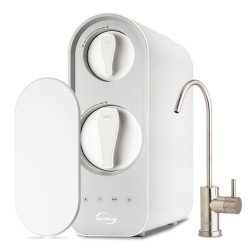
Key Points
- Train derails in an Ohio suburb, spilling toxic chemicals including Vinyl chloride and ethylene glycol monobutyl ether
- Residents are concerned about the long-term impact exposure to the chemicals involved in the crash will have on their health
- iSpring’s hearts go out to all those affected, and we remain committed to being responsible stewards of the environment and promoting customer well-being. iSpring’s reverse osmosis systems remove toxins, leaving families with pure, clean drinking water they can feel confident in
The Derailment that Led to an Ecological Disaster
There was no way East Palestine, Ohio residents could have anticipated the ecological disaster that occurred in their backyard after a train carrying hazardous chemicals derailed near the Ohio-Pennsylvania border.
Because of the high level of toxicity the chemicals involved in the spill carry and the hazardous health risks exposure could have, residents were immediately evacuated for their own safety in the aftermath of the crash.
Five days following the accident, environmental officials gave the residents the okay to return home after having closely monitored the municipal water supplies and the area’s air quality. While they continue to monitor the surrounding water and air, they assure people that the presence of harmful chemicals is below the level the CDC deems hazardous and that the area is largely safe for return. Some, however, are still being put up in hotels paid for by Norfolk Southern Railway because of contamination in a nearby creek.
Although officials appear confident the quality of both water and air supply have not been compromised, they are urging residents to drink bottled water as cleanup efforts continue with crews excavating a “grossly contaminated” 1,000-foot area around the train tracks where butyl acrylate puddled and vinyl chloride burned.
This, along with a lingering odor of chlorine and many experiencing headaches and chest pain, a burning sensation in their eyes and throats, and the death of thousands of fish as well as countless pets and livestock, have left residents gravely concerned for their health and questioning the environmental officials’ reassuring statements.
One resident noted they are limiting their water use because of unknown effects. Another wrote on Facebook, “every time we turn the water on or give my daughter a bath could potentially be hazardous.” Many live with this sort of uncertainty and fear but have nowhere to go.
Health Risks from Exposure to Spilt Chemicals
The U.S. Environmental Protection Agency (EPA) identified the chemicals being carried by the derailed cars to be vinyl chloride, ethylene glycol monobutyl ether, butyl acrylate, ethylhexyl acrylate, and isobutylene. These chemicals pose a variety of health risks, including being linked to a number of cancers.
Vinyl chloride is a gas used to make plastic and can be deadly if inhaled or if water is contaminated by this gas. This was the primary and most concerning chemical released during this spill. A variety of cancers, including liver cancer, brain and lung cancers, lymphoma, and leukemia, have been attributed to exposure to vinyl chloride.
Another chemical involved in the crash was ethylene glycol monobutyl ether (EGBE). Though EGBE can be found in things such as cosmetics and spot removers, exposure to this chemical in mass quantities can cause short-term and long-term health effects, including irritation of the skin, eyes, throat, and nose.
Additionally, EGBE is considered a carcinogen and has been linked to liver cancer and can cause reproductive hazards for both a developing fetus as well as potentially damage the male reproductive system.
The other chemicals involved in the spill also carry serious health risks and can cause lasting and irreversible health effects if inhaled or consumed.
Jeopardized Water Quality
The National Cancer Institute notes that if vinyl chloride contaminates water, it can enter the air when the water is used for showering, cooking, or laundry. This means even if one is not drinking the water, the gases in the water can be released into the air and unknowingly impact the people inhaling it.
While it is possible the vinyl chloride involved in the spill from the train derailment affected local groundwater, the Columbiana County Emergency Management Agency stated that it’s unlikely that groundwater or drinking water wells have been affected because of the location of the disaster.
While the municipal wells have been tested and deemed safe, private wells are closer to the surface and are at a higher risk for contamination.
The Ohio Environmental Protection Agency acknowledges that some waterways have been contaminated. However, they claim the contaminants are contained. They have also acknowledged that while contaminants did spill into the Ohio River, the river’s vastness has allowed for any toxins that entered this waterway to be diluted and have noted that they do not pose any sort of health threat to those who get their water from the Ohio River.
Ensuring Safe Drinking Water for Your Family
With lingering fears and anxiety about contaminants in the area's water supply, ensuring you feel safe using the water in your home is crucial. One way to do this is by using a reverse osmosis (RO) system to purify the water your family will drink and use throughout the day.
iSpring has a variety of RO systems that use multiple stages of filters to remove up to 99% of harmful water contaminants, including vinyl chloride and ethylene glycol monobutyl ether, along with over 1,000 other impurities, leaving you with peace of mind.
Not only are our under-the-sink models highly effective at removing contaminants, but they are also designed to occupy minimal room while providing you with high-quality drinking water. With an affordable cost, our RO water filtration systems are ideal for families who have concerns about their water quality as well as families who want to ditch the water bottle and save money and waste while not compromising on quality. All of our RO systems use the same filtration technology as bottling companies do to filter their water.
Three of our most popular under-the-sink models are our RCC7AK, RO500AK-BN, and RO600BN. All are top-of-the-line products and come with our high-level customer service you can trust. Our brand is one you can feel confident in and know is here for you whether you have product, install, maintenance, or troubleshooting questions; we are here for you every step of the way and allow you to contact us via chat, phone, or email.
Our RCC7AK
- is NSF/ANSI 58 certified
- uses a 6-Stage Alkaline Remineralization Layered Filtration
- produces up to 75 gallons of filtered water per day
- uses a pressurized tank to ensure a stable water flow
- can be connected directly to the refrigerator’s water supply
Our RO500AK-BN
- uses three filtration systems including a 2-in-1 composite PP Sediment and Carbon Block filter, an advanced RO Membrane, and a Carbon Alkaline Filter that balances the pH level and enhances the taste with added-back minerals
- produces up to 500 gallons of filtered water per day
- is a space-saving tankless system
- functions four times more efficiently than traditional RO systems
- provides a faster water flow, filling an 8 oz glass in 10 seconds
- features a higher pure-to-waste ratio (up to 2:1), saving water waste by up to 400% compared to traditional RO systems
- features a filter replacement light as well as easy filter replacement
Our RO600BN
- uses two filtration systems including an advanced 2-in-1 composite filter with a multi-layer architecture to capture visible particles and undesirable compounds as well as a one-tenth micron membrane to effectively eliminate contaminants
- produces up to 600 gallons of filtered water per day
- is a space-saving tankless system
- has a built in booster pump, filling an 8 oz glass in less than 10 seconds
- features a higher pure-to-waste ratio (up to 2.5:1), saving water waste by up to 400% compared to traditional RO systems
- features a filter replacement light as well as easy filter replacement
In addition to all of our systems fitting nicely under your sink and out of sight, they are also easy to install yourself, saving you money and all come with a sleek brushed nickel countertop faucet.



